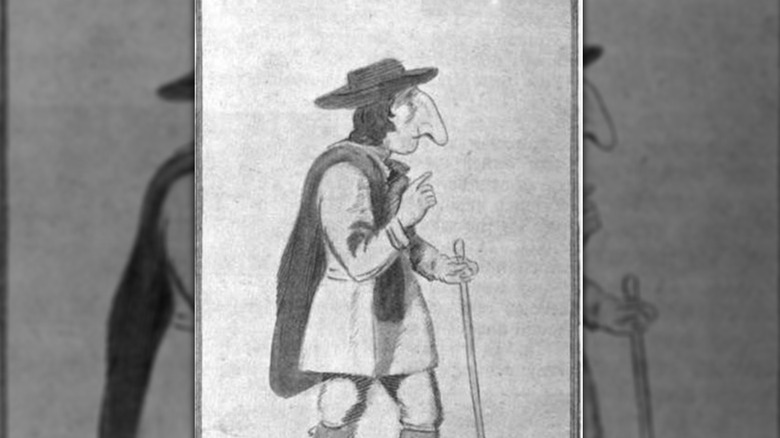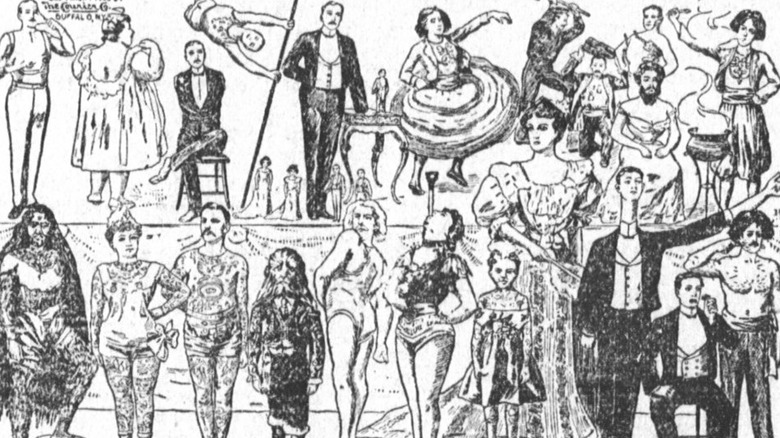The Heartbreaking Story Behind The Guinness Record Holder For The World's Longest Nose
Some say that the beauty of the human species is in our diversity. However, it has often been the case in history that society spurns those of us who look different. One only needs to read the terrible tales of Joseph Merrick (per BBC News) or Mary Ann Bevan (per All That's Interesting) to discover classic case studies of how cruel society can be. One especially heart-breaking, though mostly forgotten, story is that of Thomas Wedders, who holds the Guinness record for the world's longest nose.
Although the finer details of Wedders' life are scarce to come by, we do know a few essential elements concerning his life's path. Born in 1730, in Yorkshire, England, Thomas Wedders (sometimes known as Wadhouse) was a relatively famous circus performer in his day. Although much of his life remains shrouded in mystery, he is renowned for his nose, which grew to an astonishing 7.5 inches in length (via Economic Times).
Wedders' unique appearance marked him for a life filled with ridicule, scorn, and condescension. After all, Yale Books draws an intriguing parallel between 18th-century beauty standards and social strata. Noses were frequently used to symbolize social classes, religion, and virility. These arbitrary beauty standards were often cherry-picked to promote elitist, often racist, beauty ideals, whilst simultaneously being used to demote or demonize anyone who didn't fit in.
With that in mind, here is what we know about Thomas Wedders' enigmatic, tragic life.
Nobody nose the trouble I've seen
Anyone familiar with Joni Mitchell's beautiful poem about fame, ”The Fishbowl,” might find it contains a rather apt parallel to the life of Thomas Wedders. For those unaware, the poem presents the profound metaphor of fame as a glimmering goldfish behind glass. When all the 'ordinary' fish from the crowd comes close to gaze at the goldfish, their breath clouds the glass, and the beauty of the goldfish is lost forever.
Believe it or not, Thomas Wedders, a circus worker in 18th-century England, had a 7.5-inch-long nose! #100BIONS pic.twitter.com/4CiONAhRuY
— Ripley's Believe It or Not! (@Ripleys) April 8, 2019
Similarly, Thomas Wedders' holds a similar tragic fatalism to it. Wandering around working-class Yorkshire in the early 18th century with a 7.5 inch nose, Wedders stuck out like a sore thumb (per the book ''Anomalies and Curiosities of Medicine” by George Gould and Walter Pyle). Naturally, it was just a matter of time before Wedders' unique feature piqued the curiosity of the wider community — not to mention that there were probably plenty of physicians and medical researchers who would be too keen to turn Wedders into a walking, talking case study.
Although records of his life are few and far between, Wedders is mentioned in "The Strand Magazine Vol XI," published more than a century later in 1896. In this short feature, Wedder is cruelly mocked by implying that Wedders' had below-average intelligence. Here is just one malicious choice excerpt: ”Either his chin was too weak or his brow too low, or Nature had so exhausted herself in the task of giving this prodigy a nose as to altogether forget to endow him with brains; or perhaps, the nose crowded out this latter commodity.”
Nobody nose my sorrows
Despite society's contempt for and severe condemnation of Wedders, he built a career from his unique nose. Wedders was a circus performer in what Guinness World Records describes as a "travelling [sic.] freak circus." This occupation was sometimes the only option for people with unusual features, such as Wedders. They were forced to participate in these shows since it was one of the only avenues of income available to such outcasts in mid-18th century England (via The Lancet).
Experts were never able to pinpoint what caused his unique nose size. Wedders was posthumously awarded the Guinness World Records' title of "World's Longest Nose" after his death, a title he currently holds. In the modern day, however, a strange fate befalls poor Thomas Wedders.
Today, situated in London's very own Piccadilly Circus, lies Ripley's Believe It or Not Odditorium. If you pay the price of admission, you can find a wax bust of Thomas Wedders. Even in death, throngs of people are still queueing up to look upon Thomas Wedders' nose.


